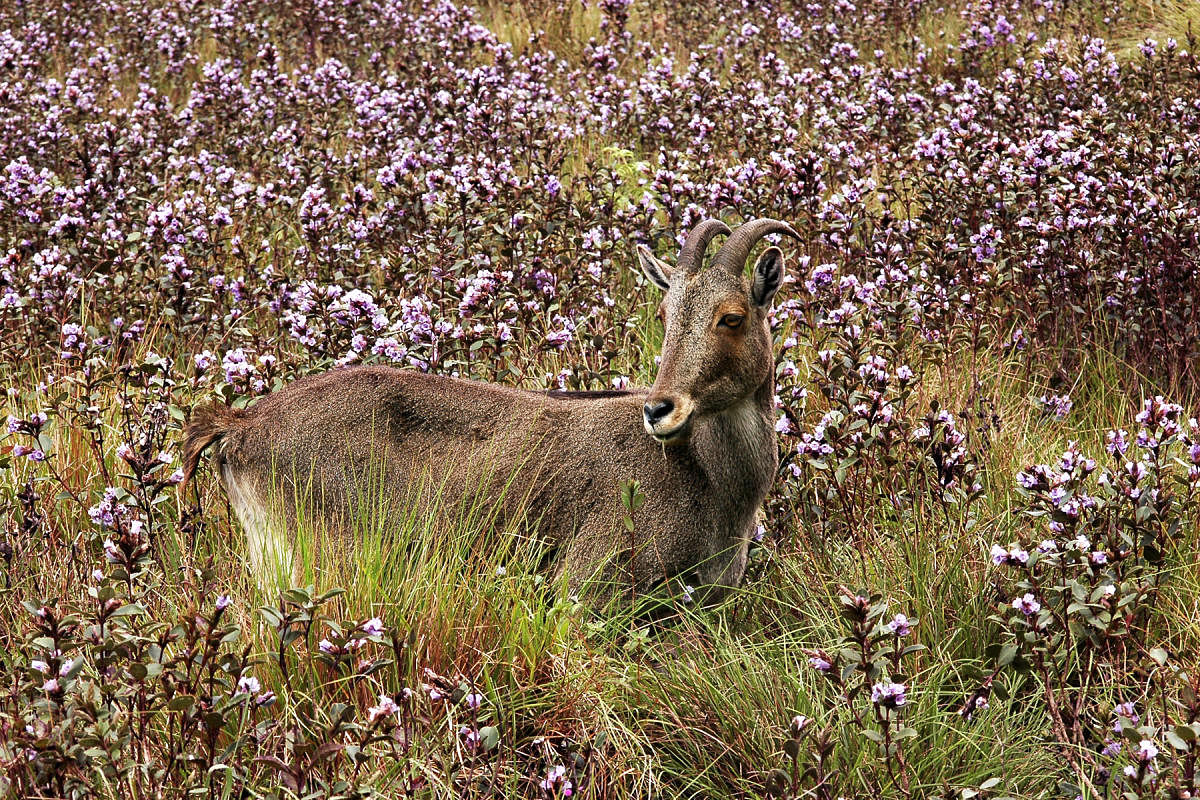
It’s often proudly termed ‘the pride of Munnar’. It’s also the hill resort’s official mascot and emblem, prominently figuring on the letterheads of local conservation NGOs. And it remains an irresistible magnet for tourists, few of whom return from Munnar without ‘interacting’ with this winsome but wild mountain goat with swept-back horns and an arresting appearance.
The Nilgiri tahr is also something of an enigma. A herd of around 60-80 tahrs inhabiting the tourism zone of Munnar’s famed Eravikulam National Park, is singularly unafraid of humans. The ungulates freely mingle with people, sometimes even eating from their hands. Indeed, it’s hard to believe that such a highly endangered animal can be so friendly and trusting. On the other hand, the herds of tahrs that rove the deep interiors of the sprawling park remain pristinely wild and wary of humans, fleeing at the very sight of them.
There’s, of course, an intriguing explanation for the radical difference in the tahrs’ behaviour. Earlier, Eravikulam was part of the landholdings of James Finlay & Company, a Scottish tea major that owned most of Munnar’s tea estates. In the early 1940s Walter Mackay, the Scottish manager of Rajamallay Estate and an ardent conservationist, was dismayed to find that the Nilgiri tahr was being indiscriminately slaughtered by poachers for its meat.
Acting decisively, Mackay prevailed upon his employers to declare the tahr’s habitat at Rajamallay a sanctuary where shooting was totally banned. A check-post, manned round the clock, was set up on the road snaking up to Rajamallay. Here all vehicles were mandatorily checked for firearms and tahr carcasses, with poachers being promptly prosecuted. Salt, a tahr favourite, was regularly put out near the road. Soon, lured by the salt-licks and assured of safety, the tahrs that had fled the area slowly began to return. Indeed they became so tame in due course that whenever Mackay drove through and honked, the herd would literally mob his car — knowing they would be rewarded with handfuls of biscuits by the delighted planter! Several old-timers nostalgically recall this heart-warming scene.
Mackay is rightly regarded as the original saviour of the Nilgiri tahr in Rajamallay which is now the tourism zone (and an integral part) of the Eravikulam National Park. The tahrs that now range freely in the tourism zone, quite unafraid of people, are descended from the herd that Mackay protected so assiduously in the 1940s, 50s and 60s. Indeed, the sight of cuddlesome tahr kids gambolling around without fear while their mothers graze contentedly will warm the cockles of anyone’s heart.
However, it hasn’t all been smooth sailing. The tahr’s flesh is regarded as a delicacy. Consequently, the threat of poaching is ever-present and constant vigilance is required to ensure the ungulate’s safety. Taking advantage of the herd’s tameness, in 1972 a poacher brazenly shot dead a tahr buck in broad daylight at Rajamallay. He then tried to use his influential political connections to get away with it. Stung to the quick, a local conservation NGO (actively backed by the tea planting community) resolutely swung into action and brought the culprit to book. This proved to be an effective deterrent to potential poachers.
Today the Nilgiri tahr is classified as a highly endangered species, having been plucked from the brink of extinction by Walter Mackay whose timely intervention and initiatives are still remembered. Subsequently, several other conservation-minded planters capably continued Mackay’s good work. There are now just around 1,000 tahrs in the Eravikulam National Park including the ‘domesticated’ herd in the tourism zone.